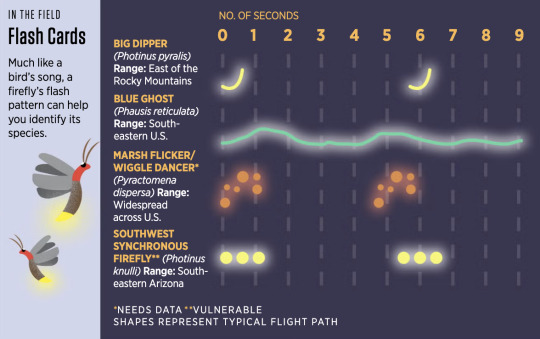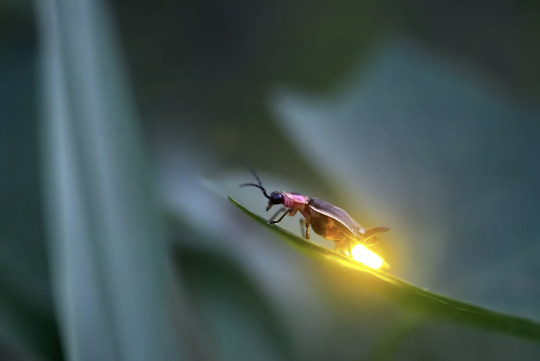Text


Excerpt from this story from Audubon:
“I can’t tell you how many people come that are like, ‘I grew up seeing fireflies, and I don’t see as many now,’ ” says Matt Johnson, the center’s director.
Candace Fallon, a conservation biologist at the Xerces Society for Invertebrate Conservation, had long heard similar concerns. But when she checked the literature in 2018, she found little to no information on firefly trends. In fact, there was no comprehensive population data for any of the 179 known firefly species in the United States.
Fallon and a team at the International Union for Conservation of Nature set out to determine how American fireflies are faring. In 2021 they published their findings, the first list of conservation statuses for U.S. fireflies. Of the 132 species they reviewed, more than half lacked enough data to conclude anything for certain. But among the species whose status was clear, the scientists found 20 to be threatened or near threatened.
Fireflies, which are actually bioluminescent beetles, face many of the same threats as birds. Habitat loss—especially of wetlands, given the insects' preference for moist areas—is a major issue. (Indeed, the most threatened fireflies are the species that depend on only one type of landscape, such as the critically endangered Bethany Beach firefly, which primarily occupies freshwater wetlands between sand dunes along a 20-mile stretch of the Delaware coast.) Rising seas and extreme weather events drown coastal birds' nests as well as firefly habitat, while pesticides kill insect prey that both fireflies and birds rely on—and likely fireflies themselves. Light pollution, which can disorient nocturnal migratory birds and contribute to fatal building collisions, also disrupts lightning bugs’ ability to communicate: Flashing in a brightly lit environment is like trying to yell across a crowd.
To help fill critical knowledge gaps, researchers are turning to community science. The Fireflyers International Network collects data on iNaturalist from all over the world, and in 2022 Fallon and the Xerces Society launched the Firefly Atlas, where U.S. participants can share incidental observations and even conduct field surveys. These crowdsourced records can illuminate how species are trending in the face of threats.
In some parts of the country, community scientists are logging the first records of fireflies. In the West, the flashing beetles are such a rare sight that some people believe they are imaginary. “It’s like: unicorns, dragons, fireflies,” says Christy Bills, an entomologist at the Natural History Museum of Utah. Western fireflies have always been harder to find: They appear late at night, in small numbers, and in marshy areas where people don’t often hang out. So Bills and her partners at Brigham Young University started the Western Firefly Project to focus attention on them. Today its participants have spotted fireflies in 27 of 29 counties in Utah, where previously there had been only a few documented sightings—and in Idaho, Wyoming, and Montana, so exciting to Bills that she likens the discoveries to finding gold.
2K notes
·
View notes
Text
Phengodes laticollis "Glowworm"


Females of this beetle are 14–20 millimeters while males are 3.3-25 millimeters, and they are native to North America! The females of this beetle are larviform, which means they resemble larvae more than the males of the same species. Males are luminecisnet (hence the name glowworm) and females/larva have glowing organs. Apparently their eggs can glow as well, though it may take up to a month. Supposedly, the females/larvae of this species are the largest light producing animal in Pennsylvania.
Images: Male of the species, and female (with glowing parts)
1000 days of Beetles (49/1000) <-Previous | Next->
27 notes
·
View notes
Text


Wriggle Nightbug Fumo I made for a friend!! I used the scraps from my recently made cosplay to make her. :D
159 notes
·
View notes
Text

my fanart of mystia as a really ugly baby sparrow
587 notes
·
View notes
Text


you may be asjking: whats this freaks problem. and to that i say. I dont know
18 notes
·
View notes
Note
This is likely a rover firefly, a species of the genus photinus -- a genus which, unfortunately, can never catch a break, as it seems 🥲 while most fireflies have relatively few predators due to their natural chemical defense lucibufagins, photinus are notable for being predated upon by female fireflies of the genus photuris, which imitate their flash pattern in order to lure them in and eat them for their lucibufagins. It's a firefly eat firefly world out there!
Edit because I forgot to mention: fireflies are notoriously un-aerodynamic flyers, just like most, if not all beetles. As such, they tend to hover close to the ground. I plead innocence for OP's coworker
no id needed, just wanted to show this firefly who flew in during one of my shifts last week!! tried to get him outside but he just wouldnt </3 suffered an unfortunate fate called My Coworker's Shoe..

Sorry but what kind of sicko kills a firefly?
123 notes
·
View notes
Text
Day 46#: July Comet Firefly
Today's animal of the day is the July Comet Firefly (Photuris lucicrescens)!

Photo credit: Bruce Marlin
Also known as the long crescendo, big scary, or big Lucy firefly, this species of beetle can be found throughout the eastern region of the United States. Like many other species of firefly (but not all) Photuris lucicrescens has a bioluminescent abdomen which they use to attract mates. During the summer, males will fly around at night and put on a light show to attract the attention of a female on the ground. When a female sees a male she likes, she will copy his pattern to call him down to mate. However, the adult stage of these beetles is actually quite short, and they spend the majority of their lives as larvae.

Photo credit: Cade Campbell
In their larval state, they live primarily underground and will eat worms, snails, slugs, and other soft-bodied invertebrates. Most species of fireflies lose the ability to eat once they transform into adults and instead rely on the nutrients that they stored up during their larval stage to provide them with enough energy to fly around and mate for a few weeks. However, the July comet and other species in the genus Photuris are what's known as "femme fatale" fireflies. Females will mimic the glow patterns of other fireflies to lure males of other species down and eat them. I guess that explains why they're sometimes called "big scaries".
31 notes
·
View notes
Text

today's bug thing is this fruit caterpillar!
981 notes
·
View notes
Text

here's an old nazrin eating cheese too as my penance for posting my stupid mario talent studio escapades in the main touhou tag
31 notes
·
View notes
Text
Whatever. Go my Wriggle Nightbug
(created in Mario Artist Talent Studio)





122 notes
·
View notes
Text

washimi doodle before i go to bed
44 notes
·
View notes





